|
GEORGE WASHINGTON BIRTHPLACE National Monument |
 |
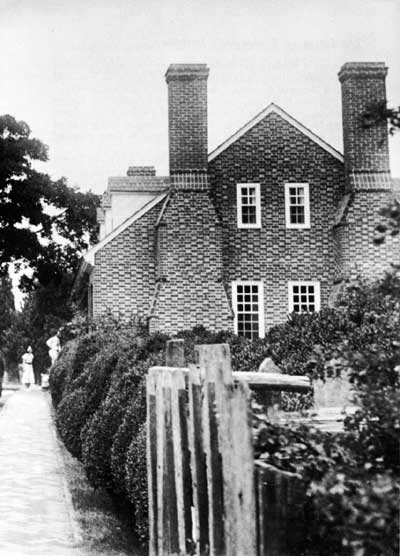
The walk from the colonial-style garden to the memorial
house.
The Saving of Washington's Birthplace
The saving of Washington's Birthplace was the work of many individuals and organizations, the Commonwealth of Virginia, the Wakefield National Memorial Association, and the United States Government.
In 1859 John E. Wilson, owner of most of the Popes Creek-Bridges Creek land, deeded to the Commonwealth of Virginia a right-of-way through his farm to the birthsite and the Washington family burying ground, together with one-half acre of land near the latter place and about 1 acre near the birthsite.
In 1882 the Commonwealth of Virginia vested title in the United States of America to its holdings at the birthsite and burying ground. By an act of Congress approved in 1879, and amended in 1881, the construction of a monument to mark the birthsite and the acquisition of the necessary ground and right-of-way had been authorized. In 1883 Mr. and Mrs. John E. Wilson sold to the United States nearly 12 acres of land surrounding the birthsite and 9.85 acres constituting a right-of-way 50 feet wide and 1.6 miles long, connecting the birthsite, the family burying ground, and the Potomac River near the mouth of Bridges Creek.
Although Congress had authorized the construction of a monument to mark the birthsite in 1881, 15 years passed before the shaft of Vermont granite was erected. It was a time in our Nation's history when historical conservation was crowded into the background in favor of more materialistic aims.
In the 1920's a group of public-spirited women became interested in the old Washington family plantation. They wanted more than a granite monument to memorialize the site where our first President was born, and dreamed of a restored tidewater plantation. On February 23, 1923, under the able leadership of Mrs. Josephine Wheelright Rust, they organized the Wakefield National Memorial Association. Their main objective was to restore the Wakefield plantation and make it a shrine for all people; the date set for completion of the task was 1932—the 200th anniversary of Washington's birth.
Shortly after the Wakefield National Memorial Association was incorporated in 1924, its members raised funds for acquiring land between the birthsite and the Washington family burying ground, and induced John D. Rockefeller, Jr., to purchase 273 acres of the old Wakefield plantation and transfer it to the United States Government. By an act of Congress, approved June 7, 1926, the association was given authority to construct a house at Wakefield as nearly as possible like the one built by Augustine Washington. In 1929 the association acquired additional land, and 2 years later donated its holding at Wakefield (about 100 acres) to the United States.
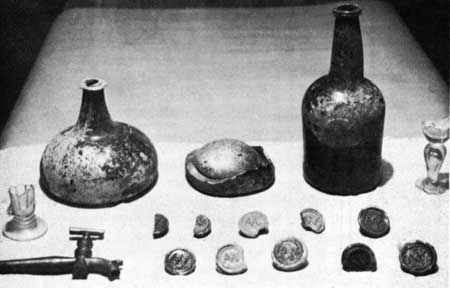
Wine bottles, glasses, seals, and bronze spigot of
1700—80 period found at Wakefield.
By an act of Congress on January 23, 1930, the 394.47 acres owned by the Federal Government was designated as George Washington Birthplace National Monument, to be administered by the National Park Service of the United States Department of the Interior.
In 1930—31 the Wakefield National Memorial Association, under its authority from Congress, built an early 18th-century style brick home as a memorial to mark the approximate site of the home in which George Washington was born. (The granite shaft which had marked the site since 1896 was moved to a new location.) As intensive research had produced very little reliable evidence concerning the appearance of the original Popes Creek home, the memorial house erected could not be a replica. It is, however, in keeping with the Virginia plantation scene at the time of Washington's association with the place.
The new memorial house was opened to the public in July 1931, and a special open house was held on February 22, 1932, the 200th anniversary of George Washington's birth. Since then the Wakefield National Memorial Association has been active in furnishing the home with suitable pieces of the 1700—50 period. In many instances 18th-century artifacts unearthed near the site of the original home have served as guides in selecting certain items. The objects excavated were surprisingly varied and revealed the nature of many furnishings which were in the original home between the time it was completed in 1726 and the time of the disastrous fire in 1779. Only a few types of the more important artifacts unearthed can be described:
GLASS. Hundreds of pieces of broken wine bottles were found, including 11 wine bottle seals bearing the initials of George's father, "AW". During the 18th century only well-to-do planters imported wine bottles from England with their names or monograms stamped on the necks of the containers. Many wine-glass stems were also found, revealing the fine assortment of drinking glasses used by the Washingtons. Numerous windowpane fragments were unearthed.

Fragments of kettle and spoons unearthed at
Wakefield.
TABLEWARE. Many bonehandled knives and forks of excellent quality were excavated, together with several types of pewter and latten metal spoons. A few of the knife and fork handles found were dyed green, described in the 1762 inventory as "green Ivory handled knives & forks."
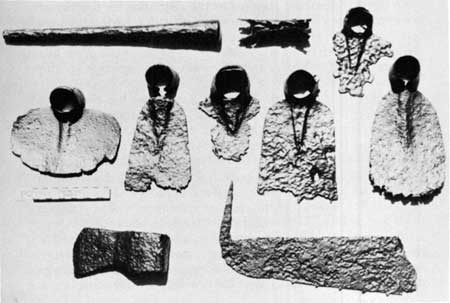
Tools unearthed near the site of the home in which
George Washington was born—iron hoes, an iron pestle, small ax,
and fragment of an ice saw. All tools shown date from 1690 to
1775.
FURNITURE HARDWARE. Many brass upholstering tacks, knobs, drawer pulls, and keyhole escutcheons, which at one time embellished high quality English furniture of the 1725—75 period, were unearthed.
CLAY PIPES. Hundreds of fragments of English white clay pipes were found in the vicinity of the birthsite.
LIGHTING DEVICES AND FIREPLACE EQUIPMENT. Brass candlesticks, candlesnuffers, and brasshandled fireplace tools excavated revealed that the Washingtons imported fine metalware from the mother country.
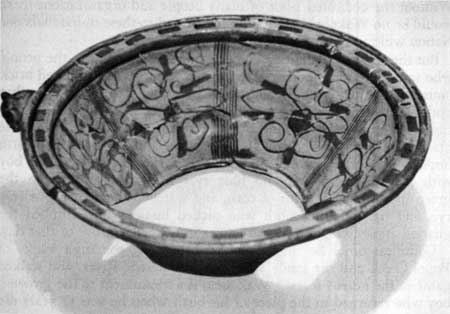
Sgraffito (scratched) earthenware bowl.
POTTERY AND PORCELAIN. Countless fragments of colorful earthenware and stoneware pottery were found, together with a fine assortment of oriental porcelain. Much of the pottery (including slip-decorated earthenware, Delftware, white salt-glazed stoneware, "Whieldon" ware, hand-decorated Staffordshire, and creamware) was made in England; some was imported from Holland (tin-glazed Delftware) and Germany (stoneware), whereas most of the porcelain came from China.
All pieces of furniture acquired by the association for the memorial house are of the early 18th-century English styles, having been made between 1700 and 1750. Only one item in the house, a tilt-top tea table, is said to have been in the original home. The last owner of the house, William Augustine Washington (George's eldest nephew), saved it at the time of the fire in 1779.
The Wakefield National Memorial Association has also acquired appropriate cooking utensils of the early 18th-century period for the colonial-style kitchen. Once again, excavated artifacts—including pot-hooks, kettle fragments, skewers, ladles, and numerous other cooking accessories—were used as guides in locating suitable kitchen equipage.
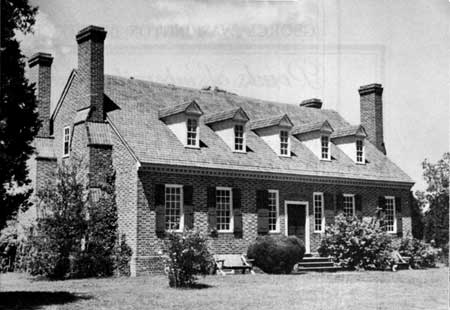
The memorial house.
Since 1932 over a million people from all parts of the world have visited Wakefield and enjoyed its natural beauties and historical associations. The serenity of the restored plantation with its cultivated fields and oldtime flower garden, its fragrant boxwood and sweet-scented herbs, and the lovely water views afforded by Popes Creek and the Potomac River, make unforgettable impressions. The memorial house furnished with beautiful and appropriate pieces from a bygone day, the early 18th-century style kitchen with its huge fireplace and ancient cooking equipment, and the family burying ground at Bridges Creek, almost 300 years old, are integral parts of the scene. In addition to these glimpses of colonial life are the well-kept grounds, the carefully tended flower beds, and the grove of native cedar trees which stand like venerable sentinels on Burnt House Point.
Such enchanting scenes which impress the senses and mind are taken for granted today, as few pilgrims realize that not so many years ago the birthplace of our Nation's First Citizen was all but forgotten. Without the dedicated labor of many people and organizations there would be no Wakefield plantation today, and to these individuals our Nation will forever owe a debt of gratitude.
But the restored plantation is more than a monument to the people who saved it. It is a memorial to the boy who played in the red brick house by the tidal creek, in the stables, barns, tobacco sheds, and other outbuildings; in the smokehouse and summer kitchen; in the spinning and weaving house and buttery; and near the forge where the blacksmith beat red-hot iron rods into tools and hardware and farm implements. The restored plantation is a shrine to the young boy with reddish-brown hair and blue eyes who romped through the green meadows and fields of corn, and watched the growing wheat, rye, and tobacco; the youth who picked luscious figs, climbed the gnarled apple trees, and played games in the cedar grove of that day.
Countless times he must have walked along the high banks of Popes Creek and the sandy shore of the Potomac River, and stalked game in the nearby forest. Wakefield is a monument to the growing boy who returned to the place of his birth when he was 11 years old and learned his first lessons in surveying. The impressions which the peaceful farm made on his mind were lasting ones, and as he grew from youth into manhood and assumed greater responsibilities, the happy memories of days spent on his father's plantation were never forgotten.

|
|
Last Modified: Mon, Jan 20 2003 10:00:00 pm PDT |


